Peter MALONE
Saturday, 18 September 2021 19:54
Murder on the Campus
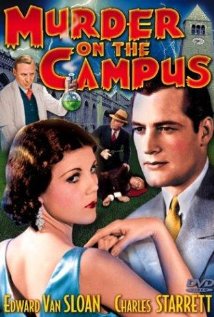
MURDER ON THE CAMPUS
US, 1933, 71 minutes, Black-and-white.
Shirley Gray, Charles Starrett, J.Farrell MacDonald?, Ruth Hall, Maurice Black, Edward Van Sloan .
Directed by Richard Thorpe.
Murder on the Campus is one of the hundreds of short films produced during the 1930s as supporting features. Many of them were murdered mysteries like this one.
Whether this is an accurate picture of life on an American campus in the early 1930s, it does not seem to matter. Police are investigating the killing of a student with minimal credentials, accepted because of athletic skills, but in relationships. A newspaper reporter is helping the police with investigations.
There is a student who went to see the murdered man and is the chief suspect. There are quite some tangles with a singer supplementing her income at a club, a gambler who runs the club, and her girlfriend and roommate.
Helping the investigations is a professor, a scientist with an interest in the case.
The dead man was locked in belltower, there was very little time for the murder to be committed, there are many clues and complications, especially with the senior and the gambler. However, it is the professor, a jealous man who did it.
The film is an early work by Richard Thorpe who was to be one of the most regularly employed directors at MGM during the 1940s and 1950s.
Published in Movie Reviews
Published in
Movie Reviews
Tagged under
Saturday, 18 September 2021 19:54
Sherlock Holmes and the Voice of Terror
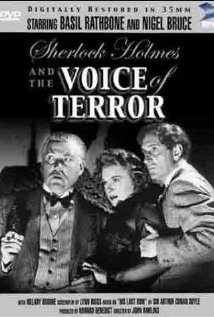
SHERLOCK HOLMES AND THE VOICE OF TERROR
US, 1942, 65 minutes, Black-and-white.
Basil Rathbone, Nigel Bruce, Evelyn Ankers, Reginald Denny, Thomas Gomez, Henry Daniell, Montague Love.
Directed by John Rawlins.
Sherlock Holmes and the Voice of Terror is the first of a series of three films with Sherlock Holmes and Dr Watson living in the contemporary world, propaganda stories at the height of World War II. This was the only film after the introductory features that was not directed by Roy William Neill.
The screenplay capitalises on propaganda radio broadcasts made during the war from both Germany and Japan. This time it is Germany. It also features the idea that the Germans had planted “sleepers” in England well before the outbreak of war, under a respectable cover, who could feed information to the broadcasts, and who could implement information, sometimes misleading, from the broadcasts, labelled The Voice of Terror.
Sherlock Holmes is called in to help unmask the radio voice by a government Council (including Henry Daniell who was to be a villain in a later film). An agent is murdered and gives a clue for the identity of the Voice, his wife, Kitty (Evelyn Ankers who was to appear as a villain in another Holmes adventure) becomes entangled with an agent, played by Thomas Gomez. This leads people to a mansion in the British countryside, on the coast, and the unmasking of the member of the Council who owns the house as a German spy. Misleading evidence about a landing on the British coast is interpreted by Holmes as an attack in another location.
There is a spirit of patriotism about the film, necessary for World War II, and Holmes and Watson contributing their part.
1. An entertaining Sherlock Holmes story? Mystery? Investigation and solution?
2. Black-and-white photography, the London settings, the British countryside, the mansion on the grounds, the coast? The musical score?
3. The Sherlock Holmes stories used as World War II propaganda, the basis in a Conan Doyle story, His Last Bow?
4. The title, the radio broadcasts, their prevalence during the war, British voices, traitors? The messages, the taunting of the British, the superiority of Germany and Hitler?
5. The council meeting, calling in Holmes, the members of the council, under suspicion or not?
6. The work of Holmes, assisted by Watson?
7. The message from the Voice of Terror? Misleading? Holmes and his interpretation, the attack on the coast? His going to the coast, the confrontation with the owner, his unmasking? The shock of the Council?
8. The murder, the victim giving a clue, his relationship with Kitty, Holmes and his friendship, using her, her contact with Meade, Meade and his role as an agent, espionage, contact with the English Lord? Holmes hunting him down?
9. The climax, the revelation of the truth, the unmasking of the villain, the reality of the intended invasion?
10. The sense of patriotism and Sherlock Holmes’ contribution to the war effort?
Published in Movie Reviews
Published in
Movie Reviews
Tagged under
Saturday, 18 September 2021 19:54
Night at the Museum: The Secret of the Tomb
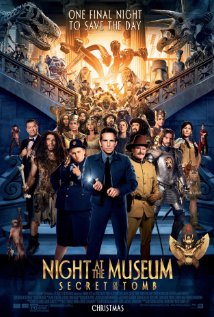
NIGHT AT THE MUSEUM: THE SECRET OF THE TOMB
US, 2014, 98 minutes, Colour.
Ben Stiller, Robin Williams, Owen Wilson, Steve Coogan, Ricky Gervais, Dan Stevens, Rebel Wilson, Skyler Gisondo, Rami Malek, Patrick Gallagher, Mizuo Peck, Ben Kingsley, Dick Van Dyke, Mickey Rooney, Bill Cobbs, Andrea Martin, Brad Garrett.
Directed by Shawn Levy.
They’re back! Who’s back? Zombies, vampires, aliens…? No, all those characters and creatures who come to life at nightfall in the New York Museum which we have visited twice before. This third film is intended as the finale, gathering together all the characters and themes.
In 2006, this was all a great novelty, and a lively entertainment. In 2009, there was a visit to Washington DC and the Smithsonian Museum. So, where to go for this encore? There has always been the special relationship between the United States and Great Britain, so why not go off to the British Museum?
There is a prologue to the film, an expedition to Egypt in 1938, a team discovery of a tomb and the transferring of the treasures back to the United States. However…, the locals repeat a warning that this could be the end. Back to 2014, the special gold plaque that was found in 1938 is beginning to corrode, the museum creatures and characters losing their power. The young son of the Pharaoh indicates that the secret lies with his father – who is preserved with his wife in the British Museum.
Getting permission from the manager, Ricky Gervais, is not easy since all the characters and creatures put on a special display for sponsors of the museum – the guests assuming that they were watching special effects whereas they were looking at the real thing, the real things. Needless to say, catastrophe ensued, the manager losing his job. But, he is persuaded to let Larry, our friendly security guard (Ben Stiller) to go to London. He takes some of the exhibits with the cowboy and the Roman Centurion (Owen Wilson and Steve Coogan) hiding in the rim of Attila’s hat!
They have all the documents to get into the British Museum, but the security guard, comedian Rebel Wilson at her chubby and cheerful best, make some difficulties – although she does fall in love with Laa, the caveman (also played by Ben Stiller to prove that he can do more than serious comic roles!). While it is a matter of finding the Pharaoh, Pharaoh (Ben Kingsley) stands on his imperial dignity. But Larry proves his worth, the secret is revealed – it needs direct moonlight to be renewed.
But, we are only halfway through the film. What else could happen? The answer is, Sir Lancelot.
He is played with tongue-in-cheek pomposity by Dan Stevens. The trouble is that Lancelot does not know much of the early history or the later history and finds contemporary English/American somewhat difficult to understand. He sees the plaque as the Holy Grail, wants to return to Camelot and claim Guinevere and confront King Arthur. By coincidence, Camelot is playing at the London Palladium, so off he rides, finding Arthur and Guinevere singing on stage, and confronts them. The Palladium audience is rather taken aback and then enters into the spirit of things, especially with Hugh Jackman and Alice Eve as Arthur and Guinevere. When he explains that he is an actor and his name is Hugh Jackman, Lancelot thinks it a silly name, Huge Ackerman. As regards other guest appearances, Larry has visited the old security guards in their nursing home for the elderly, Dick Van Dyke, doing a sprightly dance at 89, Mickey Rooney in a wheelchair, his last film appearance, and Bill Cobbs.
There are all kinds of crises, chases, deadlines before dawn, the exhibits, especially Robin Williams as Teddy Roosevelt (his vigorous performance making us regret his death even more), the cheeky monkey, Dexter, and various dinosaurs and bony creatures.
And, with the son of the Pharaoh deciding to stay with his father and mother, everybody hastens back to New York – but, instead of the sad farewell, there are a few cheerily raucous moments to say farewell to nights at the Museum.
1. Enjoyable? The conclusion of the trilogy? Audiences enjoying the characters, the novelty, history come alive? With the father and son’s story?
2. The prologue in Egypt’s, the excavations, the father and his staff, the storms, the young boy, falling into the tomb, the discovery, transferring the treasures to the United States? The warning of the locals about the end?
3. The introduction to the characters, the guests at the Museum, the director and his hosting, Larry and the discussions with the characters, the preparation, the rehearsal? The spectacle and all the characters involved? The failure, fiasco, the guests escaping? the director and his getting the sack?
4. New York, the museums? The contrast with the British Museum? London?
5. The fading of the plaque, the research, the history, the librarian and her giving the information to Larry, his visit to the old men, Cecil and his vigorous dancing, Dick Van Dyke, Mickey Rooney in his last performance in his 90s, Bill Cobb?
6. The director, being sacked, his reaction, listening to Larry’s proposal, the decision to help, phoning England?
7. To the United Kingdom, Nick going with his father, the treasures, the two little exhibits in Attila’s hat? The arrival, Tilly on guard, the discussions, the comic observations, later her sleeping, waking up, seeing the kerfuffle, meeting with Laa, attracted to him, the conversations, falling in love?
8. The familiar characters and audiences enjoying them, Robin Williams as Teddy Roosevelt, Pocahontas, Attila, the cowboy, the centurion, Pharaoh’s son? The importance of Dexter, the monkey, the comic activities? The cavemen? Laa, thinking that Larry was his father (and Ben Stiller doing both roles)?
9. Everybody in action? The special effects?
10. The quest, to find Pharaoh, the search, the difficulties in the Museum, the dinosaurs and others creatures coming alive? Pharaoh, his wife, dignity, glad to see their son? The revelation of the secret?
11. Sir Lancelot, his control over the dinosaurs? His type, not knowing his history, his quest for the Holy Grail, to confront Arthur and Guinevere, his capturing the plaque, leaving on his course, to go to Camelot, the chase through London?
12. The Palladium Theatre, the performance of Camelot, Hugh Jackman and Alice Eve, on stage, the audience, the confrontation, Hugh Jackman explaining things, Lancelot misunderstanding his name as Huge Ackman, the Wolverine manoeuvre? Only actors? Lancelot and his disappointment?
13. Time passing, the plaque corroding, the deadline, Tilly, Laa, letting them go?
14. Pharaoh’s son, the decision to stay?
15. Going back home, Larry and his farewell, everyone accepting that they would be historical exhibits, the pathos?
16. Larry and his son, the disco, the gap year, going to the United Kingdom with his father, helping in the search, making better choices at the end?
17. The happy device of the exhibits coming from the British Museum to New York, everyone coming alive again? Happy to see them again – and Tilly and Laa and the parody of Jennifer Grey and Patrick Swayze in the leap from Dirty Dancing?
Published in Movie Reviews
Published in
Movie Reviews
Tagged under
Saturday, 18 September 2021 19:54
Pi
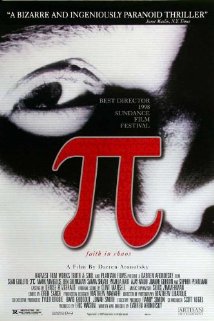
PI
US, 1998, 84 minutes, Black and white.
Sean Gullette, Mark Margolis, Ben Shankman, Pamela Hart, Stephen Pearlman.
Directed by Darren Aronofsky.
Pi is notable as the first feature film by director Darren Aronofsky, who was to make quite a career with such films as Requiem for a Dream, The Fountain, E Wrestler, Black Swan, Noah. He also wrote the screenplay and invented the story.
Sean Gulette appears as an obsessive mathematician, not quite searching for the theory of everything but for a number that will unlock the mysteries of the universe. His reclusive character is locked in his own world of mathematics. However, his work becomes the target of two different groups, one investigating Hebrew cabals, the other Wall Street financiers.
The film was made with grainy black-and-white photography and has a distinctive musical score.
A very interesting debut film for Aronofsky which raises all kinds of questions of science, meaning, as well as of human nature and obsession.
1. The impact of the film? Critical acclaim? Realism and Surrealism? As drama, as psychological portrait?
2. The director, his career, his range of subjects?
3. Black-and-white photography, stylised, grainy film, saturated light, design and framing of scenes, Max’s room, the computer screen and figures…? The atmospheric score?
4. The title, maths, numbers, patterns, application of mathematical theory, maths as the language of nature, the use of computers?
5. Max, at home, waking, the story of his looking into the Sun despite his mother’s advice, his headaches, pills, injections? His voiceover, mathematics, his explanations? Interest in Wall Street and figures, checking the lists and figures, his predictiions? The books, the board game with Sol, Sol’s advice to stop thinking, to feel, using tuition?
6. Max’s ordinary life, encounters with people, the little girl and her mathematics, the neighbour and her concern about his hair, the food, the samosas? Issues of health? On the phone, searching, no breaks? Obsessive?
7. The Jewish background, Lenny and the discussions, Kabbalah, Max saying he had no religious intersts? The importance of good deeds and God? Letters and numbers?
8. The door, its being broken open, the light? Sol and his image of Max as Icarus, too near the sun? Sol and past investigations of pie, his strike, stopping caring?
9. Max in the subway, the man singing I Only Have Eyes for You, disappearing? The later man in the subway and Max snatching the newspaper?
10. Failures, reasons, his physical condition, drugs, his getting “no results”? Sol and the stories of Archimedes, the gold, the bath, displacement, volume and density, the nature of breakthroughs?
11. Marci Dawson, the phone calls, wanting to meet Max, continued avoidance, running away? The issue of silicon and the computer?
12. The Torah, a long line of numbers? Lenny explaining the letters and numbers of father, mother, child? The searching for a pattern in the Torah, Lenny urging Max to pray, reciting the Shema?
13. Max and the world as chaotic, moves towards more predictability?
14. The nature of Max’s obsession, 216? Sol saying it could be found anywhere if that was chosen? Sol advising that if Max discarded reason he was no longer a mathematician but a numerologist?
15. The blood dripping on the subway, the vision of the brain, pressing the brain, waking on Coney island, the shell and its spirals?
16. The neighbour, borrowing the iodine, to fix the computer? Max and golden spirals, rectangles, fingerprints and images, DNA, the spirals of the Milky Way?
17. The sun, the swirling, the spirals, Max on edge, Marci and the chip? The delivery and his not opening the door? The chip, using it, failure, madness, injecting?
18. The neighbour and her help, the landlady wanting to ousting Max? Shaving his head, the continuous phone calls?
19. Sol, the computer crash, aware of its silicon, nature, the suggestion that it had computer consciousness?
20. Marci, the surveillance, wanting Max’s information, the chase, the number in his head? Home, the bath and the brain?
21. His being with the Hasidic men, the Rabbi, Lenny, the rituals and images, wanting the number, the number in the Temple, the role of the high priest, the destruction of the temple by the Romans, the loss of the secrets? The priest going into the holy of holies, pure or impure dying? The name of God with 216
letters? The key to the messianic age? Max as not pure?
22. The visual collage?
23. Sol dying, Max going into breakdown, burning the page and finally drilling into his head, destroying his brain, the little girl and his inability to do
mathematical problems?
24. The story of an obsessive man, paranoia? The importance of mathematics and interpretation of nature and the universe?
Published in Movie Reviews
Published in
Movie Reviews
Tagged under
Saturday, 18 September 2021 19:54
Laurel Canyon
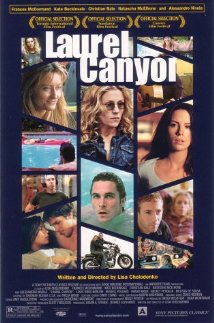
LAUREL CANYON
US, 2002, 103 minutes, Colour.
Frances Mc Dormand, Christian Bale, Kate Beckinsale, Allessandro Nivola, Natasha Mc Elhone.
Directed by Lisa Cholodenko.
Laurel Canyon is very much a Los Angeles film, especially with its beginning on the East Coast and the suggestions of its more uptight approach to life. Christian Bale and Kate Beckinsale portray a young couple, he initially more enterprising, she from a rather wealthy and buttoned-up family. She agrees to follow him to new to Los Angeles where, for a time, they live with his free-spirited mother, played by Frances Mc Dormand.
The film shows a great deal of her attitude towards life, her casual relationships, her work, her care for her son, her being intrigued by her prospective daughter-in-law. He becomes more serious, trying to deal with his mother, caught up in a relationship where he more passively succumbs to a more aggressive woman and surprised at the changes in his wife. She, on the other hand, while confining herself initially to her room and her work, becomes more and more curious about the older woman’s way of life, the men, sexuality, and succumbs to this more hedonistic Los Angeles ethos.
The film was directed by Lisa Cholodenko who received some attention with her film, High Art. She also made the intriguingly humane Cave Dweller.
1. The title, the location in Los Angeles with its reputation? Lifestyle? Inhabitants?
2. A film about relationships, partners, mother and son? Exploring relationships, changing relationships?
3. The initial sequences on the East Coast, the party, the types, snobs, academics, looking with disdain on record production?
4. Sam and Alex, the initial sexual relationship, the sensuality of Alex, the tightness of Sam? At the party, Alex’s parents, their expectations? Sam and Alex both doctors? The plan to go to Los Angeles, Sam’s work in hospital, interest in being a psychiatrist? Alex and her finishing her thesis? The focus on genes and academic explorations? The plan to go to Los Angeles, to stay at Sam’s mother’s house, his warning about Jane and her lifestyle, personality? Playing Scrabble on the plane? Competitive?
5. Arriving in Los Angeles, Jane and the entourage in the house, the awkwardness, Sam talking with his mother, the plan to get another house? Jane’s explanation of the gift of the house to a past lover, the situation?
6. Sam, driving to work, almost crashing into Sarah? Sam’s past, uptight, proper, contrasting with his parents, wanting to prove himself? At the hospital, the young man taking ecstasy, the conflict, his seeing him in the ward, the later interview with his mother, telling her to put her high values aside and have compassion for her son? Sarah, on the ward, friendship, talking?
7. Alex, support, the musicians, rehearsing the song, the drugs, sexual attitudes, especially Jane and Ian? Going out of her room, curiosity, watching the rehearsing, smoking the pot, the sexual encounter, the threesome? The effect on her, some kind of liberation? A tension with Sam on his return? His questions, criticising her? Going to look for a house, Sam and the newspapers and possibilities, the man in the house, going to live with his son, Alex pleasant with him?
8. Jane, a life, freedom, relationships with men and women? Producing the records? Reliable? Ian and the song, the lyrics, rehearsing, the band playing? Claudia phoning, the producer, exercise bike, verbal clashes with Jane? Jane and pleasant with Alex? Her being conscious that she was her son’s girlfriend?
9. Sarah, collecting Sam, the discussions, at work in the hospital, the gathering and drinking? Her perspective on relationships, love, on speaking frankly, the attraction towards Sam? His hesitations? Meeting Alex, pleasant conversation?
10. Ian, the song, the decision to have a ballad? The recording? Alex saying the former song did not draw her in but the ballad did?
11. The effect on Alex of her behaviour, saying that she could not participate in everything? Sam, his being upset?
12. Jane and Ian, Ian and his attitude towards Alex, sexual?
13. Sam, swimming in the pool, face to the camera – his future, as a psychiatrist, with Alex or not, relationship with his mother? Alex’s choices? Jane and her way of life, with men, drugs, sex and growing older?
Published in Movie Reviews
Published in
Movie Reviews
Tagged under
Saturday, 18 September 2021 19:54
Fellini Satiricon
FELLINI SATIRICON
Italy, 1969, 128 minutes, Colour.
Martin Potter, Hiram Keller, Salvo Randone, Alain Cuny, Capucine, Magali Noel.
Directed by Federico Fellini.
During the 1950s, screenwriter and sometime actor (The Miracle) Federico Fellini directed a number of films which indicated that he would be in the pantheon of great directors, La Strada and Nights of Cabiria, winning Academy Awards. In 1959 he released a masterpiece, La Dolce Vita and, in the early 1960s, 8 ½. He followed this with Juliet of the Spirits.
Fellini had a background in circus and was intrigued by the grotesque aspects of circus and carnival. While these elements were in his early films, they come to the fore in his adaptation of the work of the Roman writer, Petronius, The Satiricon, adding his own name to the title of his film. The film traces the picaresque story of two young Romans, caught up in the corruption of the era, in the world of theatre, on the galleys, in the strange world of aristocrats and depravity – along with some scenes, grim in their focus on suicide, of decent and elegant Romans.
Martin Potter, who was to have a career in his native UK, and American Hiram Keller were the two young men. Included in the cast were a number of famous Italian actors as well as the French Alain Cuny and model-turned-actress, Capucine.
The film is visually striking, with its enclosed world of the theatre, of life on the galley, in the different travels through the desert, mountains and other terrain by the two young men, along with indications of the fresco art of this period of Rome’s history.
Satiricon had quite an impact in its time, somewhat shocking for mainstream audiences at the end of the 1960s, but more interesting in later decades with audiences able to deal with themes and visuals as well as the ambiguous moral perspective.
1. The film in its time, controversy, masterpiece, in the corpus of Fellini’s work?
2. Fellini, his career, his autobiographical films, his love of circus, performance, grotesques? His perspectives on sexuality?
3. The choice of Petronius and his Satiricon, the Roman Empire, decline, decadence? His perspective on the Roman past, its relationship to the contemporary world, contemporary Italy?
4. The colour photography, the dramatic use of colour for interiors, exteriors? Costumes and decor? Make up? Special effects, grotesques? Editing and pace? The style of the musical score?
5. The work of Petronius, surviving in fragments, Fellini and his using this as a basis for the screenplay, a selection of fragments?
6. The focus on Encolpio, as the hero or anti-hero of the film? Asciolto and his presence? Gitone? Encolpio seeing him with Asciolto?
7. The opening, Encolpio and the frescoes, graffiti? His voice over, Roman student, giving up his studies, the friendship with Asciolto and then a clash, his passion for Gitnone? Seeking him?
8. Asciolto, his voiceover, creeping, his story of the sexual encounters, the actor, selling Gitone, his fighting with Encolpio?
9. The transition to the theatre, performance, the actor, the insect, breaking wind, the grotesque audience, the woman, the man taken and the cutting off of his hand? The stagecraft? The young Caesar present?
10. Encolpio, confronting Vernacchio, wanting Gitone, the actor wanting to sell him, the various offers for buying him? The entourage, the threats to burn the theatre? The transition to the amphitheatre, the entrails, the different types of make-up? Sexual behaviour, provocative, nudity? Encolpio wandering through the grotesque subterranean world, the long walk through the brothel and the various niches?
11. Encolpio, Asciolto, the rivalries? The division of all their property, but Gitone choosing Asciolto? The quake, the collapse of the building, everybody fleeing?
12. The gallery, Eumolpo, talk of Ganymede, Narcissus, Apollo, the poet talking about contemporary art, about the paintings, about the materialism of art?
13. The telling of the story, the rival poet, the transition to action outside, the cattle?
14. The vista of the red sky, candles, the crowd jumping up and down, the enormous banquet, the huge entourage? The extravagance, the food, the threat to execute the cook, exercise of mercy? The range of slaves, waiting on the people? The guests and their greed and gluttony?
15. The performance of Greek while they were eating? The unveiling of the mosaic of the host? The bitterness of Eumolpo? The host clashing with his wife, the accusation that his poetic lines were from Lucretius? Ousting Eumolpo?
16. Trimalcho, the guests, going to the mausoleum, Trimalcho anticipating his death, the grave, the mime of mourning, the greed of people wanting his wealth?
17. The story of the widow of Ephesus, her grieving, her husband, the soldier on guard, the sexual encounter, the thieves taking the body, the wife suggesting that her husband’s body be substituted to save the soldier?
18. Eumolpo, thinking he was dying, with Encolpio, bequeathing beauty and poetry to him?
19. The group arrested, on the boat, the aristocratic woman? The set of the galley, oars, the prisoners below? Gitone told there with Asciolto? Encolpio by himself? Lichas and the prisoners? Taking Encolpio’s tunic, wrestling with him, the ceremony and the marriage, the commitment? The seasons on the boat,
the enormous sea creature? The armed ships? The young Caesar killing himself, the capture of the ship?
20. The pageantry of the new Caesar arriving?
21. The domestic sequence, the master freeing the slaves, all the slaves, adults and children leaving, his tenderness towards them? His wife in attendance? The suicide? Asciolto and Encolpio arriving, seeing the wealth, the masks, the slave girl present, playing with her, in the bath, the bed, the food,
her singing, the troops burning the corpses?
22. In the desert, the nymphomaniac, taking her to the hermaphrodite, the range of clients, the thief and the two helping him steal the hermaphrodite, travelling through the desert, no water, the hermaphrodite parched, dying? The thief fighting the two, Asciolto killing him?
23. The story of the killing of the Minotaur, the battle, the mazes, the Minotaur sparing Encolpio, unmasking? The feast of mirth, the mocking of a stranger? Giving Encolpio to Ariadne, his impotence?
24. eumolpo arriving again, wealth and luxury?
25. The story of Oenothea, the fire, the cure for Encolpio, but Asciolto found dead?
26. The poet, his will, asking that his friends devour him and only then have his wealth? One hour of nausea for a life of wealth? The rationalising of the cannibalism?
27. Encolpio going travelling, the stories of his travel, and his turning into the fresco, the range of frescoes summarising the film?
Published in Movie Reviews
Published in
Movie Reviews
Tagged under
Saturday, 18 September 2021 19:54
Iceman. The/ 2013
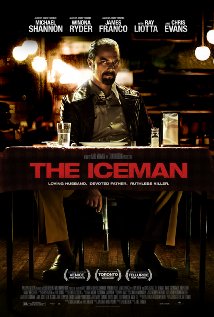
THE ICEMAN
US, 2012, 106 Minutes, Colour.
Michael Shannon, Winona Ryder, Chris Evans, Ray Liotta, David Schwimmer, Robert Davi, James Franco, Stephen Dorff.
Directed by Ariel Vroeman.
The Iceman is a very grim portrait of a hired killer, Richard Kulinski. A man of short temper, yet having a surface charm, especially with his wife and family, he was eventually arrested in 1986 and convicted.
The film introduces us to a criminal world, especially the world of pornography and, later, the copying of pornographic material and distribution through the VHS cassettes. Kulinski and his brother worked in copying videos but fell foul of a gang boss, played by Ray Liotta. He tests Kulinski and his capacity for cold-blooded killing, targeting a homeless man in the street, and then hires him to do his murders for quite some time.
Kulinski is played by Michael Shannon, who can frequently look sinister in a central role, from World Trade Center to the villain in Man of Steel. His wife, who worked as a waitress and was charmed by him, marrying him and having several children, is played by Winona Ryder.
There are quite a number of character actors in supporting roles as well is Ray Liotta, including Chris Evans as a partner, David Schwimmer (almost unrecognisable with his hairy make up) is an associate of Liotta, Stephen Dorff as a prisoner, James Franco as a villain, Robert Davi as a gangster.
Director, Ariel Croeman, is from Israel.
1. The title? true story?, Murder, the Mafia, the world? The term?
2. Managers, the city, its look, the news, student, homes, the streets? Musical score?
3. Michael Shannon in the central role, his screen presence? A blend of cold and charm? Crime sequences? Conscienceless?
4. Richard, himself, working with his brother, his brother in prison? The brief explanations of his family background, harsh? Dubbing the pornography, fulfilling orders, pressure of timetables, the visit of Demeo and his crew? Deliveries? Richard and his personality, severe and cold? Playing pool, the man refusing to pay, Richard murdering him outside in the car and walking away? Encounter in the car, the test, the beggar in the street, Richard going, shooting him, returning, passing the test? The various jobs, efficient and conscienceless?
5. Demeo, cold, commanding, his relationship with Josh? Rebuking him about using his name? The reports from Leonard Marks? Killing Josh?
6. Deborah, young, impressionable, at the diner, her work, meeting Richard, his courtesy, charm, going out? The marriage, the better house, the children, prosperity? Her good life, not suspecting anything about her husband? The years passing? The awkward meal when pornography was referred to and his changing the subject when Deborah asked questions?
7. The collage of the killings? Efficiency? His double life, seemingly religious? The payments, outings and meals? Deborah explaining the money exchange?
8. Richard’s brother, Joey, working with him, his going to prison?
9. Leonard Marks, the Mafia link, with Demeo, the demands? Richard being sacked?
10. Mr Freeze, his appearance, his truck, partnering Richard, style, conversations, the issue of freezing the bodies to confuse the police about time of death? The various killings, the chases in the street?
11. Dangers, vengeance, the encounter with Marty Freeman in his room, praying and Richard asking if his prayers were answered, killing him? The girl hiding in the cupboard, his letting her go, the risk of being discovered?
12. The arrest, the sentence? Deborah and her daughters not knowing anything, bewilderment?
13. The final information, about his career as a killer, jail, never seeinghis family again?
14. The purpose of the film, portrait of a killer, of particular times?
Published in Movie Reviews
Published in
Movie Reviews
Tagged under
Saturday, 18 September 2021 19:54
Face in the Fog
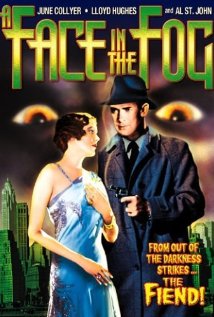
A FACE IN THE FOG
US, 1936, 66 minutes, Black and white.
June Collyer, Lloyd Hughes, Lawrence Gray, Jack Mulhall, Al St John.
Directed by Bob Hill.
This is one of those brief films, an hour or more, that entertained audiences as supporting features. It is not one of the best.
The film has both a newspaper and a theatre setting. There is a murderer on the loose, called The Fiend. He is killing performers in a musical play, using frozen bullets. An ambitious young reporter writes an article claiming that she has seen the murderer’s face – and she, therefore, is on the list for murder. She is helped by a fellow worker at the newspaper who is also assisting police in the investigations.
There are various false messages, set up so that people will be lured into situations where there will be killed, something which happens to one of the cast of the play. Also in the list of possibilities is a man who is completely suspicious, Reardon, as well is the director of the play, Fletcher, who, it seems, has had some difficulty in the past, including setting his theatre on fire.
The whole thing is pretty far-fetched, the performances adequate, with some clues, and the final revelation of the killer.
One thing that is different about this film is the musical numbers, quite an amount of the running time of the short film given over to song and dance.
A curiosity item.
Published in Movie Reviews
Published in
Movie Reviews
Tagged under
Saturday, 18 September 2021 19:54
Sherlock Holmes and the Pearl of Death
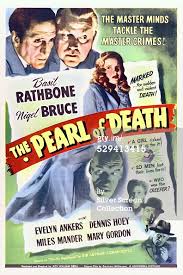
SHERLOCK HOLMES AND THE PEARL DEATH
US, 1944, 69 minutes, Black and white.
Basil Rathbone, Nigel Bruce, Dennis Hoey, Evelyn Ankers, Miles Mander, Ian Wolfe, Rondo Hatton.
Directed by Roy William Neill.
The Pearl of Death is one of the later Sherlock Holmes- Dr Watson films with Basil Rathbone and Nigel Bruce, directed by Roy William Neill. It is based on Conan Doyle’s story The Six Napoleons.
The film is not a mystery because the villain is known right from the beginning, Evelyn Ankers as Naomi Drake, stealing a famous pearl on a liner, asking an old clergyman to bring it through customs, not realising that the clergyman was Holmes in disguise who immediately gives the Pearl back to the museum. However, the villain steals the jewel again, is chased by the authorities, ducks into a shop and hides the jewel in a bust of Napoleon, is then arrested but let go because of the lack of evidence.
A series of murders ensues, customers who bought the busts of Napoleon being murdered by a large killer, manipulated by the villain. Holmes works out what has happened, the hiding of the jewel in the shop, the nature of the murders, the search for the jewel.
Which all leads to a final confrontation with the large killer and the villain, Holmes triumphant.
1. The popularity of the series of Sherlock Holmes films? Of Holmes and Watson in general? Their appearances in so many different films?
2. Black-and-white photography, studio work, the liner, British locations, the British Museum?
3. Basil Rathbone as Sherlock Holmes, the complete impersonation? And the bumbling Nigel Bruce as Dr Watson? Their teamwork? Watson’s naivete? Holmes shrewdness? Logic – and elementary?
4. A mystery, theft, murders?
5. The title, the jewel, the robbery on the liner, passing through customs, Holmes returning the jewel to the Museum, the further theft, its being hidden, the discovery?
6. Holmes, disguised as the clergyman, the encounter with Naomi Drake, asking him to take the jewel through customs? His work with the director? Returning the jewel?
7. Pride in the security system, the demonstration, the details, protection of the picture, the stealing of the jewel? The chase, the villain going into the shop (and Holmes later reconstructing the time span with Watson), hiding the jewel, letting himself be arrested, the interrogation, the ruse of having the meals delivered to him, the information, the contact with Naomi Drake? being let go?
8. The series of seeming random murders? The murder scenes, the backs of the victims broken, the scattered crockery? Holmes discovering the design of the smashing of the crockery?
9. The Hoxton Creeper, the big man, the visuals, Conover and his control, the killing of the victims?
10. Homes, the solution, the shop, the list of customers, the busts of Napoleon, the series of murders of the owners, the last owner, Holmes arriving in time,
protection of the victim, the confrontation with the Creeper, Conover and his presence, Holmes tricking the Creeper into killing Conover?
11. A satisfactory solution – based on Conan Doyle’s The Six Napoleons?
Published in Movie Reviews
Published in
Movie Reviews
Tagged under
Saturday, 18 September 2021 19:54
Sherlock Holmes in Washington
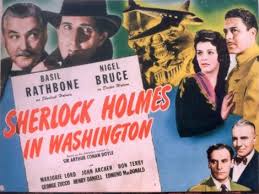
SHERLOCK HOMES IN WASHINGTON
US, 1943, 71 minutes, Black and white.
Basil Rathbone, Nigel Bruce, Marjorie Lord, Henry Daniell, George Zucco, John Archer, Thurston Hall.
Directed by Roy William Neill.
Basil Rathbone and Nigel Bruce first appeared as Sherlock Holmes and John Watson in the 1939 The Adventures of Sherlock Holmes, an upmarket film from 20th Century Fox. They continued their partnership in more than a dozen films, smaller budget, made by Universal Studios.
In the 1940s, three of their films were made as war propaganda, this film, Sherlock Holmes and the Voice of Terror and Sherlock Holmes and the Secret Weapon. It is easy to look at them, even look down at them, from the 21st century vantage point, considering them just propaganda, but this was deemed necessary for the war effort in the 1940s.
A courier takes a government document to the United States and is abducted after the flight. The government, some members unwillingly, ask Sherlock Holmes to go to America to retrieve the document. Of course, Dr Watson goes with him and there is some comedy about American customs, language, chewing gum… with Dr Watson.
Henry Daniell is aboard the plane and responsible for a group of spies. But the main the villain is played by George Zucco (who had been Moriarty in an earlier film). Here he is an antique dealer, posing as an American, but organising a spy network.
Along the way there are some interesting characters, Clarence Muse as the waiter on the train, an elderly lady on the train with mice, the young woman who inadvertently has the document in her possession, on microfilm.
After various manoeuvres in Washington – along with some touches of touristic abuse – Holmes works out who the villain is and where he is, goes in disguise but is unmasked, confronts the villain who has abducted the girl but has not realised that he is not looking for a document but for microfilm concealed in a container of matches.
The film becomes even more patriotic with speeches by Holmes at the end, echoing Winston Churchill about the American – British Alliance, with hopes that after the war human beings will be more humane and moral.
The film was directed by Roy William Neill, who directed most of these films.
1. The popularity of the series of Sherlock Holmes films? Of Holmes and Watson in general? Their appearances in so many different films?
2. The war effort, taking Sherlock Holmes and Dr Watson to Washington, espionage implications? The British government, their concern, the couriers, the deaths of their couriers, the retrieving of the document?
3. Black-and-white photography, American locations, rear-projection of Washington scenes? The American atmosphere, the humour of comment on the differences between Britain and the United States?
4. Basil Rathbone as Sherlock Holmes, the complete impersonation? And the bumbling Nigel Bruce as Dr Watson? Their teamwork? Watson’s naivete? Holmes shrewdness? Logic – and elementary?
5. The voyage on the plane, the spies on board, Grayson and his presence, drunk, trying to mislead the spies? His abduction, his death? Lighting a cigarette Nancy, transferring the microfilm?
6. Holmes’ visit to Grayson’s mother, the touch of pathos? The discovery of questions interest in microfilming?
7. Holmes on the train, the interlude with that letter? The woman with the mice and the fuss? The sinister and the later visit?
8. Nancy, her cigarette, the microfilm in her purse, her fiance, his concern, abduction by the villain?
9. The government officials? Their concern? The background of espionage? Couriers and documents? The American British Alliance?
10. The villain, his background, disguise, the antique shop, Holmes and his disguise, identifying the wood and the furniture? His confrontation with the villain,
the taunting, Holmes and his background with microfilm, the explanations, the concealment, the revelation?
11. The patriotic speeches at the end? The spirit of World War II and propaganda?
Published in Movie Reviews
Published in
Movie Reviews
Tagged under